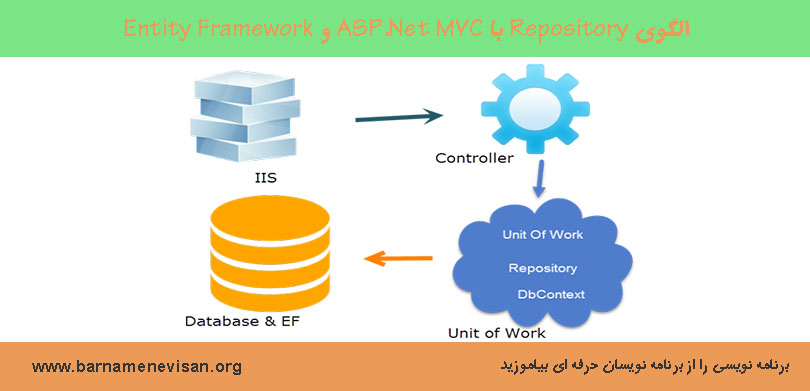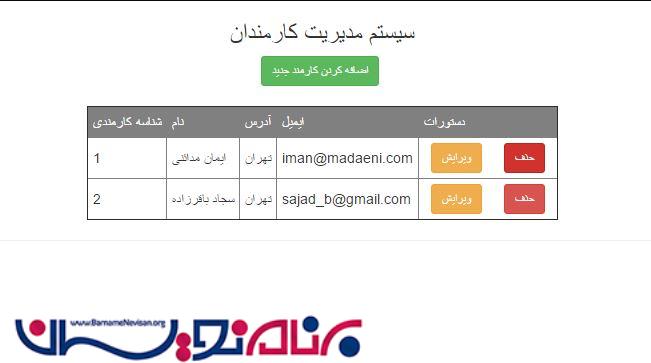الگوی Repository با ASP.Net MVC و Entity Framework
سه شنبه 27 مهر 1395Repository Pattern برای ایجاد یک لایه مجزا بین data access layer و business logic layer یک برنامه مورد استفاده قرار میگیرد . در این مقاله با ارائه یک مثال ساده ، شما را با Repository Pattern در ASP.Net و Entity Framework آشنا خواهیم کرد .

Repository بصورت مستقیم با لایه DAL در ارتباط است و از آن داده هایی را دریافت و برای لایه BAL آماده میکند . مهم ترین مزیت استفاده از Repository Pattern ایزوله کردن لایه های data access layer و business logic layer میباشد .
در این قسمت ما ، قصد بررسی Repository Pattern در ASP.Net و Entity Framework را داریم .
مرحله اول :
• ابتدا visual studio را باز کنید .
• یک پروژه web جدید ایجاد کنید .
• در مرحله بعد ASP.Net MVC 4 را انتخاب کنید .
• Empty Template را انتخاب کنید .
مرحله دوم :
دو کلاس EmployeeContext.cs و Employee.cs را در فولدر Models ایجاد کنید . ما در این مثال از روش Code First استفاده میکنیم و نیازی به ایجاد جدول ها در پایگاه داده نیست ، و با همین کدها بصورت خودکار جداول ما در پایگاه داده ایجاد خواهد شد .
Employee.cs
using System;
using System.Collections.Generic;
using System.ComponentModel.DataAnnotations;
using System.ComponentModel.DataAnnotations.Schema;
using System.Linq;
using System.Web;
namespace RepositoryWithMVC.Models
{
[Table("Employee")]
public class Employee
{
[Key]
[Display(Name = "شناسه کارمند")]
public int EmployeeId
{
get;
set;
}
[Display(Name = "نام کارمند")]
[Required(ErrorMessage = "وارد کردن نام اجباریست")]
public string EmployeeName
{
get;
set;
}
[Display(Name = "آدرس")]
[Required(ErrorMessage = "وارد کردن آدرس اجباریست")]
public string Address
{
get;
set;
}
[Display(Name = "ایمیل")]
[Required(ErrorMessage = "وارد کردن ایمیل اجباریست")]
public string EmailId
{
get;
set;
}
}
}
EmployeeContext.cs
using System;
using System.Collections.Generic;
using System.Data.Entity;
using System.Linq;
using System.Web;
namespace RepositoryWithMVC.Models
{
public class EmployeeContext : DbContext
{
public EmployeeContext() : base("DefaultConnection") { }
public DbSet<Employee> Employees
{
get;
set;
}
}
}
Web.Config
<connectionStrings>
<add name="DefaultConnection" connectionString="data source=(local); database=Demodb; user id=sa; password=xyz;" providerName="System.Data.SqlClient" />
</connectionStrings>
توجه داشته باشید که ، فیلد های Connection string را باید ویرایش کنید و اطلاعات پایگاه داده خود را وارد کنید .
مرحله سوم :
یک فولدر با نام "Repository" ایجاد کنید . یک کلاس و یک Interface با نام
IEmployeeRepository.cs و EmployeeRepository.cs به آن اضافه کنید .
IEmployeeRepository.cs
using RepositoryWithMVC.Models;
using System;
using System.Collections.Generic;
using System.Linq;
using System.Web;
namespace RepositoryWithMVC.Repository
{
public interface IEmployeeRepository : IDisposable
{
IEnumerable<Employee> GetAllEmployee();
Employee GetEmployeeById(int studentId);
int AddEmployee(Employee employeeEntity);
int UpdateEmployee(Employee employeeEntity);
void DeleteEmployee(int employeeId);
}
}
EmployeeRepository.cs
using RepositoryWithMVC.Models;
using System;
using System.Collections.Generic;
using System.Data;
using System.Linq;
using System.Data.Entity;
using System.Web;
namespace RepositoryWithMVC.Repository
{
public class EmployeeRepository : IEmployeeRepository
{
private readonly EmployeeContext _context;
public EmployeeRepository(EmployeeContext context)
{
_context = context;
}
public IEnumerable<Employee> GetAllEmployee()
{
return _context.Employees.ToList();
}
public Employee GetEmployeeById(int studentId)
{
return _context.Employees.Find(studentId);
}
public int AddEmployee(Employee employeeEntity)
{
int result = -1;
if (employeeEntity != null)
{
_context.Employees.Add(employeeEntity);
_context.SaveChanges();
result = employeeEntity.EmployeeId;
}
return result;
}
public int UpdateEmployee(Employee employeeEntity)
{
int result = -1;
if (employeeEntity != null)
{
_context.Entry(employeeEntity).State = EntityState.Modified;
_context.SaveChanges();
result = employeeEntity.EmployeeId;
}
return result;
}
public void DeleteEmployee(int employeeId)
{
Employee employeeEntity = _context.Employees.Find(employeeId);
_context.Employees.Remove(employeeEntity);
_context.SaveChanges();
}
private bool disposed = false;
protected virtual void Dispose(bool disposing)
{
if (!this.disposed)
{
if (disposing)
{
_context.Dispose();
}
}
this.disposed = true;
}
public void Dispose()
{
Dispose(true);
GC.SuppressFinalize(this);
}
}
}
مرحله چهارم :
یک EmployeeController که مستقیم با Repository در ارتباط است را به پروژه اضافه کنید :
using RepositoryWithMVC.Models;
using RepositoryWithMVC.Repository;
using System;
using System.Collections.Generic;
using System.Linq;
using System.Web;
using System.Web.Mvc;
namespace RepositoryWithMVC.Controllers
{
public class EmployeeController: Controller
{
private IEmployeeRepository _employeeRepository;
public EmployeeController()
{
_employeeRepository = new EmployeeRepository(new Models.EmployeeContext());
}
public EmployeeController(IEmployeeRepository employeeRepository)
{
_employeeRepository = employeeRepository;
}
public ActionResult Index()
{
var model = _employeeRepository.GetAllEmployee();
return View(model);
}
public ActionResult AddEmployee()
{
if (TempData["Failed"] != null)
{
ViewBag.Failed = "Add Employee Failed";
}
return View();
}
[HttpPost]
public ActionResult AddEmployee(Employee model)
{
if (ModelState.IsValid) {
int result = _employeeRepository.AddEmployee(model);
if (result > 0) {
return RedirectToAction("Index", "Employee");
} else {
TempData["Failed"] = "Failed";
return RedirectToAction("AddEmployee", "Employee");
}
}
return View();
}
public ActionResult EditEmployee(int EmployeeId)
{
if (TempData["Failed"] != null) {
ViewBag.Failed = "Edit Employee Failed";
}
Employee model = _employeeRepository.GetEmployeeById(EmployeeId);
return View(model);
}
[HttpPost]
public ActionResult EditEmployee(Employee model)
{
if (ModelState.IsValid) {
int result = _employeeRepository.UpdateEmployee(model);
if (result > 0) {
return RedirectToAction("Index", "Employee");
} else {
return RedirectToAction("Index", "Employee");
}
}
return View();
}
public ActionResult DeleteEmployee(int EmployeeId)
{
Employee model = _employeeRepository.GetEmployeeById(EmployeeId);
return View(model);
}
[HttpPost]
public ActionResult DeleteEmployee(Employee model)
{
if (TempData["Failed"] != null) {
ViewBag.Failed = "Delete Employee Failed";
}
_employeeRepository.DeleteEmployee(model.EmployeeId);
return RedirectToAction("Index", "Employee");
}
}
}
مرحله پنجم :
برای متدهای View ، Controller ایجاد میکنیم :
Index.cshtml
@model IEnumerable<RepositoryWithMVC.Models.Employee>
@{
ViewBag.Title = "Index";
} <div align="center">
<h3> سیستم مدیریت کارمندان </h3> <span> <a href="/Employee/AddEmployee" class="btn btn-success btn-sm"> اضافه کردن کارمند جدید </a></span>
<br />
<br />
<table cellpadding="5"
border="1">
<tr style="background-color:#808080; color:white;">
<td>
شناسه کارمندی
</td>
<td>
نام
</td>
<td>
آدرس
</td>
<td>
ایمیل
</td>
<td>
دستورات
</td>
</tr>
@foreach (var emp in Model)
{
<tr>
<td>
@emp.EmployeeId
</td>
<td>
@emp.EmployeeName
</td>
<td>
@emp.Address
</td>
<td>
@emp.EmailId
</td>
<td>
@*<a href = "@Url.Action("EditEmployee", "Employee ", new { id = emp.EmployeeId })" > Edit </a>*@
 @Html.ActionLink("ویرایش", "EditEmployee", new { id = emp.EmployeeId },new{@class="btn btn-warning btn-sm"})
  
@Html.ActionLink("حذف", "DeleteEmployee", new { id = emp.EmployeeId },new{@class="btn btn-danger btn-sm"}) 
</td>
</tr>
}
</table>
</div>
AddEmployee.cshtml
@model RepositoryWithMVC.Models.Employee
@{
ViewBag.Title = "AddEmployee";
}
<div align = "center" >
<h3 > مدیریت کارمندان</h3> <br/>
<b> اضافه کردن کارمند جدید </b> <br/>
<br/>
@{
ViewBag.Title = "AddEmployee";
}
<div align = "center" >
<br/>
@using (Html.BeginForm("AddEmployee", "Employee", FormMethod.Post))
{ <table >
<tr >
<td colspan = "2" >
@if (ViewBag.Failed != null)
{ <span style = "color:red;" > @ViewBag.Failed </span>
} </td> </tr> <tr >
<td >
@Html.LabelFor(e => e.EmployeeName) </td> <td >
@Html.TextBoxFor(e => e.EmployeeName) <br/>
@Html.ValidationMessageFor(e => e.EmployeeName, null, new { style = "color:red ;"})
</td> </tr> <tr >
<td >
@Html.LabelFor(e => e.Address) </td> <td >
@Html.TextBoxFor(e => e.Address) <br/>
@Html.ValidationMessageFor(e => e.EmployeeName, null, new
{
style = "color:red;"
}) </td> </tr> <tr >
<td >
@Html.LabelFor(e => e.EmailId) </td> <td >
@Html.TextBoxFor(e => e.EmailId) <br/>
@Html.ValidationMessageFor(e => e.EmployeeName, null, new
{
style = "color:red;"
}) </td> </tr> <tr >
<td colspan = "2"
align = "center" >
<br/>
<input type = "submit" class="btn btn-success btn-sm"
value = "ثبت"/>
</td> </tr> </table>
} </div> </div>
EditEmployee.cshtml
@model RepositoryWithMVC.Models.Employee
@{
ViewBag.Title = "Edit Employee";
}
<div align = "center" >
<h3 >مدیریت کارمندان</h3> <br/>
<b> ویرایش کارمندان </b> <br/>
<br/>
@using (Html.BeginForm("EditEmployee", "Employee", FormMethod.Post))
{
@Html.HiddenFor(e => e.EmployeeId) <table>
<tr >
<td colspan = "2" >
@if (ViewBag.Failed != null)
{ <span style = "color:red;" > @ViewBag.Failed </span>
} </td> </tr> <tr>
<td >
@Html.LabelFor(e => e.EmployeeName) </td> <td>
@Html.TextBoxFor(e => e.EmployeeName) <br/>
@Html.ValidationMessageFor(e => e.EmployeeName, null, new
{
style = "color:red;"
}) </td> </tr> <tr >
<td>
@Html.LabelFor(e => e.Address) </td> <td>
@Html.TextBoxFor(e => e.Address) <br/>
@Html.ValidationMessageFor(e => e.EmployeeName, null, new
{
style = "color:red;"
}) </td> </tr> <tr>
<td>
@Html.LabelFor(e => e.EmailId) </td> <td>
@Html.TextBoxFor(e => e.EmailId) <br/>
@Html.ValidationMessageFor(e => e.EmployeeName, null, new
{
style = "color:red;"
}) </td> </tr> <tr>
<td colspan = "2"
align = "center" >
<br/>
<input type = "submit" class="btn btn-primary btn-sm"
value = "بروزرسانی"/>
</td> </tr> </table>
} </div>
DeleteEmployee.cshtml
@model RepositoryWithMVC.Models.Employee
@{
ViewBag.Title = "Delete Employee";
}
<div align = "center" >
<h3 > مدیریت کارمندان </h3> <br/>
@using (Html.BeginForm("DeleteEmployee", "Employee", FormMethod.Post))
{
@Html.HiddenFor(e => e.EmployeeId) <table border = "1"
cellpadding = "10" >
<tr >
<td colspan = "2"
align = "center" >
<b > حذف کارمندان </b>
@if (ViewBag.Failed != null)
{ <span style = "color:red;" > @ViewBag.Failed </span>
} </td> </tr> <tr >
<td >
@Html.LabelFor(e => e.EmployeeName) </td> <td >
@Html.TextBoxFor(e => e.EmployeeName, new
{
@readonly = "readonly"
})
</td> </tr> <tr >
<td >
@Html.LabelFor(e => e.Address) </td><td >
@Html.TextBoxFor(e => e.Address, new
{
@readonly = "readonly"
})
</td> </tr> <tr >
<td >
@Html.LabelFor(e => e.EmailId) </td> <td >
@Html.TextBoxFor(e => e.EmailId, new
{
@readonly = "readonly"
})
</td> </tr> <tr >
<td colspan = "2"
align = "center" >
<br/>
<input type = "submit" class="btn btn-danger btn-sm"
value = "حذف"/>
</td> </tr> </table>
} </div>
خروجی برنامه بصورت زیر خواهد شد :

آموزش asp.net mvc
- ASP.net MVC
- 4k بازدید
- 9 تشکر
